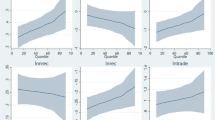Abstract
Endogenous growth is generally built on a positive externality hypothesis which is the opposite of a negative externality caused by pollution. We study a linear technology with simple assumption: an aggregate capital stock which represents a learning by doing effect and a pollution flow proportional to production. In this framework, we analyse the precise effects on growth of the disutility of pollution and its interaction with the utility of consumption in an economy without abatement technology. The decentralized equilibrium always leads to unlimited growth, but optimal growth is often limited (the negative effect of pollution dominating the positive effect of learning by doing). In this case, the optimal policy which leads the decentralized economy to follow the optimal growth path is to tax capital; in contrast with the optimal subsidy policy in an economy without pollution. When an abatement technology is introduced, the optimal solution can lead the economy to unlimited growth, whatever the form of the utility function.
Similar content being viewed by others
References
Arrow, K. J. (1962), ‘The Economic Implications of Learning by Doing’,Review of Economic Studies 80, 155–173.
Arrow, K. J. and M. Kurz (1970),Public Investment, the Rate of Return and Optimal Fiscal Policy, Johns Hopkins Press, Baltimore.
Asako, K. (1980), ‘Economic Growth and Environmental Pollution under the Max-Min Principle’,Journal of Environmental Economic and Management 7, 157–183.
Bovenberg A. L. and S. Smulders (1993), ‘Environmental Quality and Pollution-Saving Technological Change in a Two-Sector Endogenous Growth Model’, Center Discussion Paper 9321, Tilburg University.
Bovenberg, A. L. and S. Smulders (1994), ‘Transitional Impacts of Environmental policy in an Endogenous Growth Model’, mimeo, Tilburg University.
Forster, B. A. (1980), ‘Optimal Energy Use in a Polluted Environment’,Journal of Environmental Economic and Management 7, 321–333.
Forster, B. A. (1975), ‘Optimal Pollution Control with a Nonconstant Exponential Rate of Decay’,Journal of Environmental Economic and Management 2, 1–16.
Gruver, G. W. (1976), ‘Optimal Investment in Pollution Control Capital in a Neoclassical Growth Context’,Journal of Environmental Economic and Management 3, 165–177.
Howarth, R. B. and R. B. Norgaard (1992), ‘Environmental Valuation under Sustainable Development’,American Economic Review 80, 473–477.
Hung, V. T. Y., P. Chang, and K. Blackburn (1992), ‘Endogenous Growth, Environment and R & D’, paper presented at ‘The International Dimension of Environmental Policy’, Milan.
Keeler, E., M. Spence and R. Zeckhauser (1971), ‘The Optimal Control of Pollution’,Journal of Economic Theory 4, 19–34.
Lucas, R. (1988), ‘On the Mechanics of Economic Development’,Journal of Monetary Economics 22, 3–42.
Luptacik, M. and U. Schuber (1982), ‘Optimal Investment in Productive Capacity and Pollution Abatement Processes in a Growing Economy’, in Feichtinger, ed.,Optimal Control Theory and Economic Analysis I, North-Holland.
Michel, P. (1990), ‘Some Clarifications on the transversality Condition’,Econometrica 53(3), 705–723.
Michel, P. (1992), ‘Pollution and Growth towards the Ecological Paradise’, CME Université Paris I; manuscript.
Romer, P. M. (1986), ‘Increasing Returns and Long-Run Growth’,Journal of Political Economy 94, 1003–1037.
Romer, P. M. (1989), ‘Capital Accumulation in the Theory of Long-Run Growth’, in Barro, ed.,Modern Business Cycle Theory, Basil Blackwell.
Romer, P. (1990), ‘Endogenous Technological Change’,Journal of Political Economy 98, 71–102.
Ryder, H. E. and G. M. Heal (1972), ‘Optimal Growth with Intertemporally Dependent Preferences’,Review of Economic Studies 39, 1–31.
Siebert, H. (1987),Economics of the Environment, Theory and Policy, Springer-Verlag (third edition: 1992).
Smith, V. L. (1972), ‘Dynamics of Waste Accumulation: Disposal Versus Recycling’,Quarterly Journal of Economics 86, 600–616.
Tahvonen, O. and J. Kuuluvainen (1991), ‘Optimal Growth with Renewable Resources and Pollution’,European Economic Review 35, 650–661.
Tahvonen, O. and J. Kuuluvainen (1993), ‘Economic Growth, Pollution and Renewable Resources’,Journal of Environmental Economic and Management 24, 101–118.
Tahvonen, O. (1991), ‘On the Dynamics of Renewable Resource Harvesting and Pollution Control’,Environmental and Resource Economics 1, 97–117.
Van der Ploeg, F. and C. Withagen (1991), ‘Pollution Control and the Ramsey Problem’,Environmental and Resource Economics 1, 215–236.
Author information
Authors and Affiliations
Rights and permissions
About this article
Cite this article
Michel, P., Rotillon, G. Disutility of pollution and endogenous growth. Environ Resource Econ 6, 279–300 (1995). https://doi.org/10.1007/BF00705982
Issue Date:
DOI: https://doi.org/10.1007/BF00705982




